Drosera Section Arachnopus
Under the Microscope
Hartmeyer,
S. (2004) Carniflora Australis (AUSCPS)
Number 3: 11-17 (Deutscher Text: "Neues
vom Sonnentau")
The Indian Sundew (Drosera indica)
occurs with a huge extension, from South Africa over Madagascar up to
India and through Southeast Asia down to Australia. The plant colour
reaches from yellowish-green to dark red, the flowers are white, orange or
pink - or start white and become pink after some days - and the size
varies from only a few centimetres (i.e.: Howard Springs, Australia) up
to respectable more than 150 cm (i.e.: South Africa). They all grow in
tropical or subtropical environments. Despite of several obviously
distinct varieties, until December 2000 they all have been classified as
one species into the monotypic (since the three North Queensland Sundews
have been separated into section Prolifera) Drosera section Arachnopus.
Then Dr. Jan Schlauer described the Australian D. hartmeyerorum, and
classified it as a second species on its own into section Arachnopus.
Closely related to D. indica, this dark red plant from the Eastern
Kimberley is clearly distinguished by light yellow emergences of approx.
tentacle size at the leaf base, which are even unique for the whole genus.
Their purpose or function is still puzzling and object of further
investigation (News
on this topic in our Artikel Drosera
hartmeyerorum - Der Sonnentau
mit Lichtreflektoren Hartmeyer, I.
& Hartmeyer, S. (2006) DAS TAUBLATT (GFP)
2006/3: 4-9). But there is one more surprise: the microscope shows very
minute and distinct structures spread over the leaves of different
varieties of D. indica.
At the 4th International Carnivorous Plant Conference
in Tokyo (Japan 2002) I have been invited by Prof. Kondo to show parts of
our video "FLEISCHIMANIA", on which the yellow (magnified)
emergences of D. hartmeyerorum are visible (including plants and
habitat). This species found a lot of interest and I was very pleased, when
after the lecture Prof. Dr. Stephen Williams (Lebanon Valley College, USA)
offered a common project (together with Prof. Al Wolf and Dr. Regina
Kettering) to investigate the species with a Scanning Electron Microscope (SEM).
Well, to realise such a project would normally be very expensive. so i
agreed without hesitation. The chemicals to prepare some Sundew leaves -
grown from seed at our greenhouse in Weil am Rhein, Germany - arrived soon
from Pennsylvania, USA, and only a few days later I returned the specimen
for the SEM investigation. This is still ongoing, however, I am very
grateful for the approval of Stephen and his team, to show the excellent two
SEM-pictures (figures 1 and 2), to accompany this article.
|
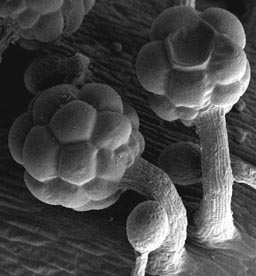 |
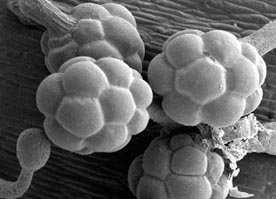 |
SEM-pictures of Drosera
hartmeyerorum SCHLAUER by Dr.
Regina Kettering. Published with the kind approval of
Prof. Dr. Stephen Williams and his team at the Lebanon Valley College, USA.
The collapsed cell on one emergence shows, that the "lenses" are hollow. The
normal tentacles beside allow to match the size. |
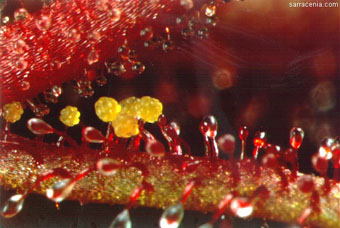 |
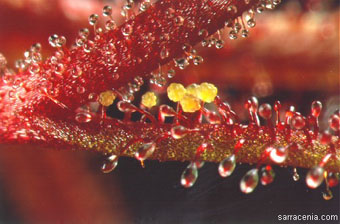 |
Drosera
hartmeyerorum SCHLAUER photographed by Dr.
Barry A. Rice (www.sarracenia.com/faq.html)
with a special lens combination.
A good comparison between the
yellow emergences and the deep red leaves. |
The description of the yellow emergences
caused a discussion on the Internet and motivated several persons world wide
to take a closer look through the microscope. Thus I was again very pleased,
when I received some excellent colour photos (Figure 3 & 4) by Dr. Barry
A. Rice (editor of "Carnivorous Plant Newsletter", ICPS)
who did not use a microscope, but a special combination of photo-lenses to
achieve the great magnification. Again I am very grateful for Barry's
approval to show them to accompany this article. Together with the SEM
pictures a good general impression of the unique yellow emergences becomes
possible.
The story was getting even more exciting when Dr. Eberhard
König (Germany) told me, that the big green D. indica that he has on
his list, shows very minute mushroom-like structures on the whole lamina.
Visible only under a microscope with 200 times magnification. I recalled a
comment by Stephen Williams (private communication), that apparently the
"head" of the yellow emergences of D. hartmeyerorum is built by
only a few giant cells (one "lens" = one single cell). Could it be
possible that varieties of D. indica can be distinguished by those very
small structures which have not been found until now, because of their
minuteness?
At a meeting of the German CPS
"GFP" in Wuerzburg (German town) 2002, I met Andreas Fleischmann
who has an excellent knowledge on the Droseraceae. He also found different
very minute emergences on his D. indica and offered some seeds of
such varieties. They germinated well and thanks to a weekly feeding with
fish-food (using tweezers with a magnifier) they grew quickly. For closer
observations I decided to buy a USB-microscope (Internet order approx. US$
250,-), which is connected directly to the computer (by USB port) enabling
30 and 200 times magnification. A light source is integrated and combined
with a laptop the microscope can be used even in the field on living plants.
Unfortunately the resolution of the resulting pictures is just poor, but
good enough to get more information. A high quality microscope with camera
adapter would be 10-20 times more expensive!
When the plants had grown big
enough to investigate the adult leaves, I needed 200 x magnification and
could then clearly confirm the observations of Eberhard Koenig and Andreas
Fleischmann. As mentioned above: the resolution of the resulting pictures is
only poor for printing, but I believe they are interesting enough to show
them. |
|
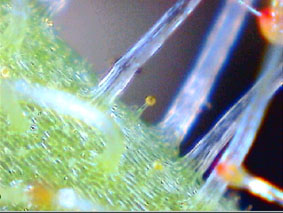 |
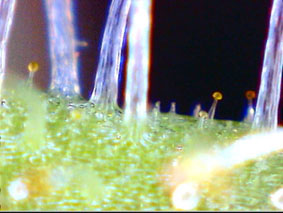
|
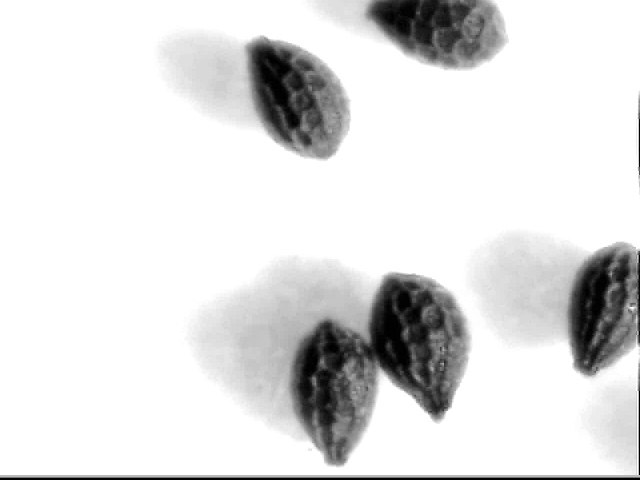
|
| Drosera aff. indica "white flower"
(200 x mag. - USB mic.) - growing in South Africa - small mushroom-like yellow emergences
appear. |
Seeds
of D. hartmeyerorum
200 x mag. |
|
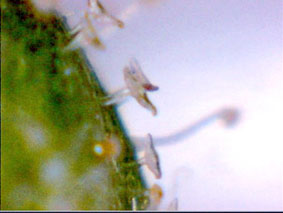
On
this Drosera serpens (200x mag. - USB mic.) - growing in the Eastern Kimberley - the whole lamina
shows several only 0.1 - 0.2 mm small emergences with yellow heads.
|
(Left photo)
This former D. indica "pink flower" from the Eastern Kimberley (AUS) has been renamed in 2014 into Drosera serpens.
(Names corrected here in January 2016) |
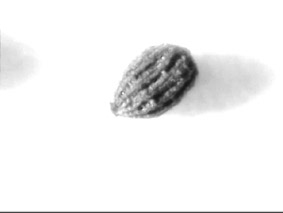
Seed of
D. serpens
200x mag.
|
Due
to the huge extension of D. indica it will be a long lasting and hard work
for everybody who tries to publish an extensive and complete documentation
of all varieties (or new species?) of this Sundew. To investigate the very
minute emergences on the world-wide existing dried herbaria specimen will
certainly be not so easy. And in addition there is still a bigger problem:
no matter if anybody is looking on the minute emergences, genome or seed
structures of the species, actually, at this time much more field
observations will still be necessary because several unexplored growing
sites between the African and the Australian eastcoast are still waiting
with unexpected surprises.
The
intention of this article was not to deal with any new species names, but to
motivate CP enthusiasts to focus on the
minute emergences on D. indica varieties at their own collection.
There are more different emergences than the shown examples! Godd luck! It would be great
to hear from you by email.
References:
Hartmeyer,
S. (2003), Neues vom Sonnentau: Die Sektion Arachnopus unter dem Mikroskop.
DAS TAUBLATT 2003/3:04-08.
Schlauer,
J. (2001), Drosera hartmeyerorum spec. nov. (Droseraceae), a New
Sundew in Sect. Arachnopus from North Australia.
CARNIVOROUS PLANT
NEWSLETTER 30/4:104-106.
Hartmeyer,
I. & Hartmeyer, S. (2001), Observations on a New Drosera species
in the Ord River Region (Australia). CARNIVOROUS PLANT NEWSLETTER 30/4:
107-110.
Hartmeyer, I. &
Hartmeyer, S. (2001), FLEISCHIMANIA, Hunting
Veggies®
Digital Video, 60 minutes (German and English
language), private production.
Hartmeyer,
I. & Hartmeyer, S. (2002), THE 4th INTERNATIONAL CARNIVOROUS PLANT
CONFERENCE IN TOKYO,
Hunting
Veggies®
Digital Video,
170 minutes (English language), private production.
|
|